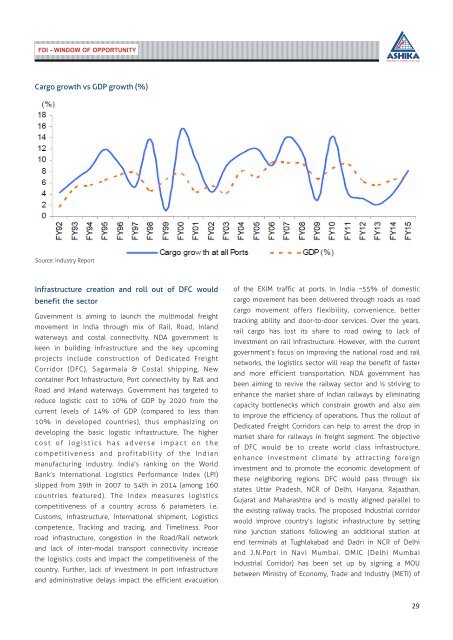You also want an ePaper? Increase the reach of your titles
YUMPU automatically turns print PDFs into web optimized ePapers that Google loves.
FDI - WINDOW OF OPPORTUNITY<br />
Cargo growth vs GDP growth (%)<br />
Source: Industry Report<br />
Infrastructure creation and roll out of DFC would<br />
benefit the sector<br />
Government is aiming to launch the multimodal freight<br />
movement in India through mix of Rail, Road, Inland<br />
waterways and costal connectivity. NDA government is<br />
keen in building infrastructure and the key upcoming<br />
projects include construction of Dedicated Freight<br />
Corridor (DFC), Sagarmala & Costal shipping, New<br />
container Port Infrastructure, Port connectivity by Rail and<br />
Road and Inland waterways. Government has targeted to<br />
reduce logistic cost to 10% of GDP by 2020 from the<br />
current levels of 14% of GDP (compared to less than<br />
10% in developed countries), thus emphasizing on<br />
developing the basic logistic infrastructure. The higher<br />
c o s t o f l o g i s t i c s h a s a d v e r s e i m p a c t o n t h e<br />
competitiveness and profitability of the Indian<br />
manufacturing industry. India’s ranking on the World<br />
Bank’s International Logistics Performance Index (LPI)<br />
slipped from 39th in 2007 to 54th in 2014 (among 160<br />
countries featured). The Index measures logistics<br />
competitiveness of a country across 6 parameters i.e.<br />
Customs, Infrastructure, International shipment, Logistics<br />
competence, Tracking and tracing, and Timeliness. Poor<br />
road infrastructure, congestion in the Road/Rail network<br />
and lack of inter-modal transport connectivity increase<br />
the logistics costs and impact the competitiveness of the<br />
country. Further, lack of investment in port infrastructure<br />
and administrative delays impact the efficient evacuation<br />
of the EXIM traffic at ports. In India ~55% of domestic<br />
cargo movement has been delivered through roads as road<br />
cargo movement offers flexibility, convenience, better<br />
tracking ability and door-to-door services. Over the years,<br />
rail cargo has lost its share to road owing to lack of<br />
investment on rail infrastructure. However, with the current<br />
government’s focus on improving the national road and rail<br />
networks, the logistics sector will reap the benefit of faster<br />
and more efficient transportation. NDA government has<br />
been aiming to revive the railway sector and is striving to<br />
enhance the market share of Indian railways by eliminating<br />
capacity bottlenecks which constrain growth and also aim<br />
to improve the efficiency of operations. Thus the rollout of<br />
Dedicated Freight Corridors can help to arrest the drop in<br />
market share for railways in freight segment. The objective<br />
of DFC would be to create world class infrastructure,<br />
enhance investment climate by attracting foreign<br />
investment and to promote the economic development of<br />
these neighboring regions. DFC would pass through six<br />
states Uttar Pradesh, NCR of Delhi, Haryana, Rajasthan,<br />
Gujarat and Maharashtra and is mostly aligned parallel to<br />
the existing railway tracks. The proposed Industrial corridor<br />
would improve country’s logistic infrastructure by setting<br />
nine junction stations following an additional station at<br />
end terminals at Tughlakabad and Dadri in NCR of Delhi<br />
and J.N.Port in Navi Mumbai. DMIC (Delhi Mumbai<br />
Industrial Corridor) has been set up by signing a MOU<br />
between Ministry of Economy, Trade and Industry (METI) of<br />
29




